Abstract
Background:
There is very little data on the consequence of menopause on women in South East Asia region, especially from rural India. Importance is always given to reproductive health from menarche to menopause. Menopausal health demands priority in Indian scenario due to rising population of postmenopausal women.
Objectives:
The aim was to determine the mean age at attaining menopause and the prevalence of various self-reported menopausal symptoms complained by postmenopausal women (40-54 years). Furthermore, to determine the prevalence of anxiety and depression among postmenopausal women.
Materials and Methods:
A cross-sectional study was conducted in a rural area of New Delhi among 252 postmenopausal women from October 2011 to March 2013. A pretested, self-designed, semi structured, interview based, oral questionnaire was used. The Statistical Package for Social Sciences software Version 21.0 (SPSS) was used for analyses.
Results:
The mean age at attaining menopause was 46.24 (Standard Deviation = 3.38) years. Only 4 (1.6%) postmenopausal women had premature menopause. A total of 225 (89.3%) postmenopausal women experienced at least one or more menopausal symptom(s). The most common complaints of postmenopausal women were sleep disturbances (62.7%), muscle or joint pain (59.1%), hot flushes (46.4%) and night sweats (45.6%). A total of 32.1% (n=81) postmenopausal women suffered from depression and 21.0% (n=53) postmenopausal women suffered from anxiety.
Conclusion:
It is necessary to critically introspect health needs of postmenopausal women and specific components can be incorporated in the national health programs.
Keywords: Menopause, menopausal symptoms, postmenopausal women, rural
INTRODUCTION
Menopause refers to last menstrual period.[1] Menopause is defined as the time of cessation of ovarian function resulting in permanent amenorrhea.[2] According to the World Health Organization, it takes 12 months of amenorrhea to confirm that menopause has set in. In 1990, about 25 million women worldwide reached menopause; this number is expected to double by the late 2020s.[3] About 130 million Indian women are expected to live beyond menopause by 2015.[4] With the advent of modern medicine, there is a general increase in life expectancy, thus many women are likely to live for more than two decades beyond menopause, in an estrogen deficient state.[5] Some of the menopausal symptoms experienced by these women can be severe enough to affect the normal lifestyle.[6] Menopause related symptoms have been extensively studied in western countries, but very little data is available from developing countries, especially South East Asia.[6] According to Indian Menopause Society, there were about 65 million Indian women over the age of 45 years in the year 2006. Hence, menopausal health demands even higher priority in Indian scenario.[7] In India, there is no current health program that caters to the specific health needs of postmenopausal women. Moreover, Reproductive and Child Health-II and National Rural Health Mission only addresses women in the reproductive age group, ignoring those who have passed their reproductive stage.[8] Also very few studies have been conducted in rural areas to understand menopause at micro level.[1] Since majority of Indian population resides in rural areas that is 68.84% (2011),[9] therefore there is an urgent need to focus our health services to postmenopausal women residing in rural areas. This study is therefore expected to bring out the magnitude of suffering due to health issues among postmenopausal women, which can be addressed at proper platform of sociocultural relevance.
MATERIALS AND METHODS
A population based, cross sectional study was conducted in Dichaon Kalan village, Najafgarh, located in South-West district, New Delhi. Dichaon Kalan village comes under one of the subcentres of Rural Health Training Centre (RHTC), Najafgarh, New Delhi. At the time of the study, there were three subcentres under RHTC, Najafgarh. Study area Dichaon Kalan village was selected from these three subcentres using simple random sampling (Lottery method). The study was carried out from October 2011 to March 2013. All postmenopausal women between the age of 40-54 years living in the study area who satisfied the inclusion and exclusion criteria were included in the study. Inclusion criteria for the study were postmenopausal women with at least 1 year of amenorrhea and those who had attained natural menopause in last 5 years. Postmenopausal women who have recently attained menopause that is within 5 years were included in the study to minimize recall bias. Women with a known history of chronic diseases such as hypertension, diabetes, migraine, cardiovascular disease, tumors, tuberculosis, rheumatoid arthritis, and osteoarthritis were excluded from the study.
A total of 539 women were approached by house-to-house survey in the village. Among them, 252 postmenopausal women fulfilled the inclusion criteria and were included in the study.
The mean age at attaining menopause was determined. The self-reported menopausal symptoms of postmenopausal women were studied. The prevalence of anxiety and depression among postmenopausal women was also determined.
The study instrument consisted of a pretested, self-designed, semi structured, oral, interview based questionnaire. The pretesting of the study instrument was done in a village of Fatehpur Beri, New Delhi. After analysis of the results from pretesting, changes were made in the study instrument. The components of the questionnaire were as follows:
A pretested, semi-structured questionnaire was used to assess the sociodemographic profile and age at attaining menopause of postmenopausal women.
For assessing the socioeconomic status of postmenopausal women, Uday Pareek scale for rural areas was used.[10]
For studying menopausal symptoms, an interview based, pretested, validated, semi structured and printed questionnaire in Hindi language was used. The questionnaire was designed on lines of the questionnaires used across the world for studying menopausal symptoms that is Menopause specific Quality of Life questionnaire, Menopausal Rating Scale and same had been acknowledged in references.[5,6,11] The menopausal symptoms reported by the study subjects were taken for a recall period of last 3 months from the date of interview. The menopausal symptoms assessed in the study were self-reported symptoms by the study subjects. Menopausal symptoms assessed in the study were divided into six categories: Vasomotor, psychosomatic, psychological, sexual, urinary complaints and “others”.
Hamilton Anxiety Rating Scale (HAM-A)[12] and the Hamilton Depression Rating Scale (HAM-D)[13] were used to assess the psychological menopausal problems that is anxiety and depression respectively.
Ethical clearance was obtained from the appropriate authorities. Due permission was obtained from Director, RHTC, Najafgarh, New Delhi. Informed written consent was obtained from all the study subjects before the start of the study.
The Statistical Package for the Social Sciences software Version 21.0 (SPSS, an IBM company) was used for analysis. The descriptive statistics were calculated for the background variables and for the prevalence of the selected menopausal symptoms.
RESULTS
A total of 252 postmenopausal women were included in the study. The response rate was 100%. It was observed that the maximum number of postmenopausal women (137 i.e. 54.4%) were in the age group 50-54 years. The mean age of postmenopausal women was found to be 49.05 (Standard Deviation = 3.85) years.
Table 1 shows the distribution of postmenopausal women according to their sociodemographic characteristics. Figure 1 shows the distribution of postmenopausal women according to socioeconomic status of their family.
Table 1.
Distribution of postmenopausal women according to sociodemographic characteristics, Dichaon Kalan village, Najafgarh, New Delhi, 2012 (n = 252)
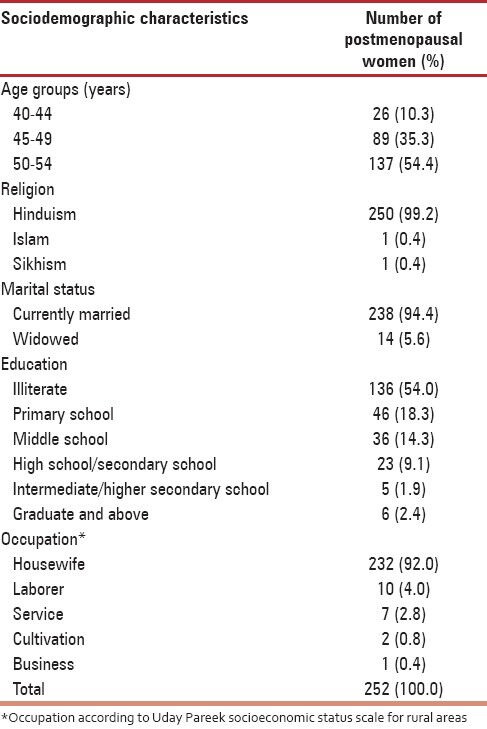
Figure 1.
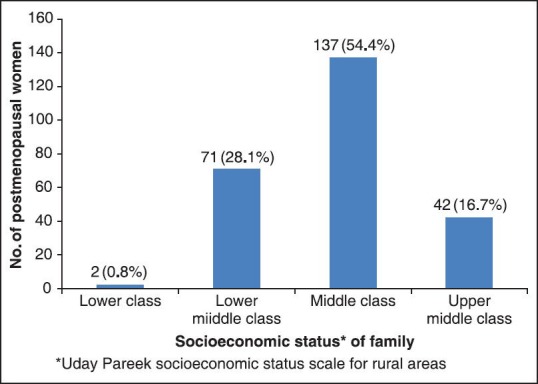
Distribution of postmenopausal women according to socioeconomic status of the family, Dichaon Kalan village, Najafgarh, New Delhi, 2012 (N = 252)
Figure 2 shows the distribution of postmenopausal women according to age at attaining menopause. Maximum proportion of postmenopausal women (55.2%) attained menopause between the age of 45-49 years. Merely 4 (1.6%) postmenopausal women had premature menopause that is menopause before the age of 40 years. The mean age at attaining menopause was 46.24 (Standard Deviation = 3.38) years, with a range from a minimum age of 38 years to a maximum age of 53 years. Figure 3 shows the distribution of postmenopausal women according to the presence or absence of menopausal symptoms. A total of 225 (89.3%) postmenopausal women experienced at least one or more menopausal symptom(s). Table 2 shows the distribution of postmenopausal women according to the prevalence of different menopausal symptoms. The most common complaints of postmenopausal women were sleep disturbances (62.7%), muscle or joint pain (59.1%), hot flushes (46.4%) and night sweats (45.6%). Figure 4 shows the distribution of postmenopausal women according to the severity of depression and anxiety. It was observed that 32.1% (mild: 31%, moderate: 1.1%) postmenopausal women suffered from depression and 21.0% (mild: 18.3%, moderate: 2.7%) postmenopausal women suffered from anxiety. No postmenopausal woman was found to be suffering from severe or very severe depression/anxiety.
Figure 2.
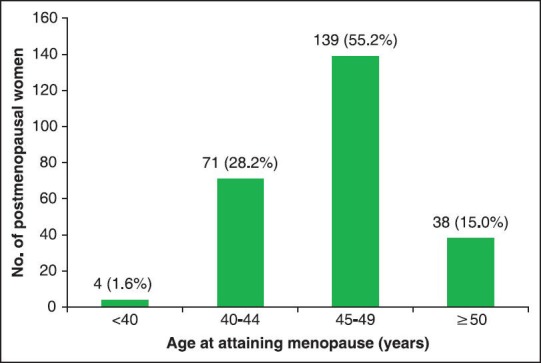
Distribution of postmenopausal women according to age at attaining menopause, Dichaon Kalan village, Najafgarh, New Delhi, 2012 (N = 252).
Figure 3.

Distribution of postmenopausal women according to presence of menopausal symptoms, Dichaon Kalan village, Najafgarh, New Delhi, 2012 (N = 252)
Table 2.
Distribution of postmenopausal women according to menopausal symptoms, Dichaon Kalan village, Najafgarh, New Delhi, 2012 (N = 252)
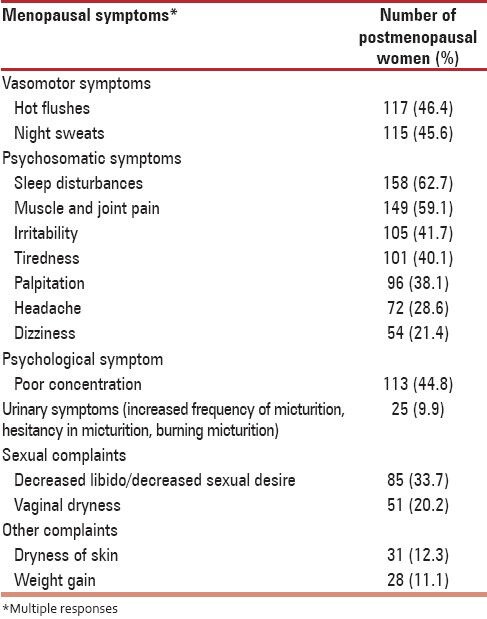
Figure 4.
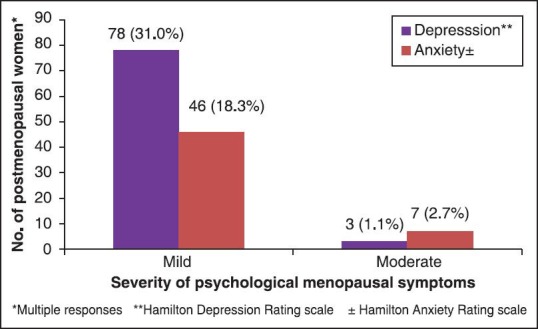
Distribution of postmenopausal women according to severity of anxiety and depression, Dichaon Kalan village, Najafgarh, New Delhi, 2012 (N = 252)
DISCUSSION
Table 3 shows mean age of women at attaining menopause in various studies. In the present study, only 1.6% postmenopausal women had premature menopause. In the study conducted by Dasgupta and Ray[14] (2007, West Bengal), only 4% of the women attained menopause before the age of 40 years. This suggests that the prevalence of women attaining menopause before the age of 40 years is very low. A total of 225 (89.3%) postmenopausal women experienced at least one or more menopausal symptom(s). The most common complaints of postmenopausal women were sleep disturbances (62.7%), muscle or joint pain (59.1%), hot flushes (46.4%) and night sweats (45.6%).
Table 3.
Mean age of women at attaining menopause in various studies

In the current study, 47.4% postmenopausal women complained of hot flushes. This finding is comparable to finding in the studies carried out by Madhukumar et al.[8] (2012, Bengaluru), Nusrat et al.[18] (2008, Pakistan), Sharma et al.[15] (2004-05, Jammu) and Dutta et al.[19] (2012, Tamil Nadu), in which the prevalence of hot flushes were found to be 55.9%, 59.4%, 53.86% and 60.9%, respectively.
Prevalence of night sweats in the current study was found to be 45.6%. This is consistent with the findings of the studies carried out by Sharma et al.[15] (2004-05, Jammu), Madhukumar et al.[8] (2012, Bengaluru), Sagdeo and Arora[20] (2007-09, Nagpur) and Rahman et al.[6] (2010, Bangladesh), in which the prevalence of night sweats were found to be 53.86%, 36.7%, 35.8% and 48.3%, respectively.
Sleep disturbances was reported by 62.7% postmenopausal women in the current study. This is comparable to the results in the studies conducted by Dasgupta and Ray[14] (2007, West Bengal), Aaron et al.[21] (2002, Tamil Nadu) and Rahman et al.[6] (2010, Bangladesh), in which the prevalence of sleep disturbances were found to be 70.0%, 52.0% and 54.4%, respectively.
In this study, 59.1% postmenopausal women complained of muscle or joint pain. Similar findings were observed in the studies conducted by Sagdeo and Arora[20] (2007-09, Nagpur), Nusrat et al.[18] (2008, Pakistan) and Sharma et al.[15] (2004-05, Jammu), in which the prevalence of muscle or joint pain were found to be 60.4%, 66.74% and 53.86%, respectively.
Irritability was reported by 41.7% of postmenopausal women in the present study. This finding was consistent with results of Kaulagekar[4] (2011, Pune), Rahman et al.[6] (2010, Bangladesh) and Sharma et al.[15] (2004-05, Jammu).
It was observed that 40.1% postmenopausal women in the present study reported tiredness. Comparable results were found in the studies conducted by Monterrosa et al.[22] (2006-07, Columbia) and Khan and Hallad[1] (2004, Karnataka).
Similar to the prevalence of palpitation (29.95%) observed by Kaulagekar[4] (2011, Pune), in the current study, 38.1% postmenopausal women complained of palpitations. This finding was similar to the findings of the study carried out by Monterrosa et al.[22] (2006-07, Colombia), in which the prevalence of palpitation was observed to be 26.8% among Non-Afro-Colombian women and 38.8% among Afro-Colombian women.
The prevalence of headache in the present study was observed to be 28.6%. Kaulagekar[4] (2011, Pune) observed almost equivalent prevalence (26.8%) of headache. Aaron et al.[21] (2002, Tamil Nadu) and Khan and Hallad[1] (2004, Karnataka) observed the prevalence of headache to be 35.0% and 19.8%, which is comparable to the finding of the current study.
In the current study, 9.9% postmenopausal women had urinary complaints. This is comparable with results of the studies conducted by Rahman et al.[6] (2010, Bangladesh) (12.8%) and Khan and Hallad[1] (2004, Karnataka) (9.9%). Monterrosa et al.[22] (2006-07, Colombia) found urinary complaints in 14.9% of Afro-Colombian women.
Decreased libido or decreased sexual desire was reported by 33.7% of postmenopausal women in the present study. Rahman et al.[6] (2010, Bangladesh) (31.2%) and Gollschewski et al.[23] (2004, Queensland) (34.5%) observed similar results.
More than a quarter of postmenopausal women suffered from depression, which is a matter of concern. Rahman et al.[6] (2010, Bangladesh) found the prevalence of depressive mood to be 37.3%. Poomalar and Arounassalame[24] (2012, Puducherry) reported the prevalence of depressed mood to be 57.2%. Furthermore in this study, 21.1% postmenopausal women were found to be suffering from either mild or moderate anxiety. Poomalar and Arounassalame[24] (2012, Puducherry) and Ayranci et al.[16] (2008, Turkey) found the prevalence of anxious mood as 67.2% and 78.8%, respectively. The variation in the findings of depression and anxiety in the current study from the findings of other studies could probably be because of the reason that, the above mentioned studies reported the prevalence of depressed and anxious mood rather than actual depression and anxiety; and no psychiatric scale was used by them.
Thus almost 90% postmenopausal women in the study area suffered from one or more menopausal symptom(s), which is a matter of concern and cannot be ignored.
Limitations of this study were that it was a cross sectional study thus temporal association between cause and effect cannot be established. Longitudinal studies could be conducted in future as they would be more useful in assessing the menopausal symptoms. Furthermore, retrospective information was collected from the postmenopausal women, which could have led to recall bias.
CONCLUSION
Proportion of women attaining premature menopause was very low. A large proportion of postmenopausal women suffered from menopausal symptoms. The most common menopausal complaints reported by the postmenopausal women were sleep disturbances, muscle or joint pain, hot flushes and night sweats. Sexual life was also affected by menopause. Moreover, postmenopausal women suffered from depression and anxiety.
Thus government could concentrate on providing health services to women in post reproductive age group also besides women in the reproductive age. This can be achieved by incorporating components related to specific health needs of postmenopausal women in the national health programs.
Footnotes
Source of Support: Nil
Conflict of Interest: None declared.
REFERENCES
- 1.Khan HG, Hallad SJ. Age at menopause and menopausal transition: Perspectives of Indian rural women. [Last accessed on 2011 Aug 27]. Available from: http://www.epc2006.princeton.edu/download .
- 2.Howkins J, Bourne G. Perimenopause, menopause, premature menopause and postmenopausal bleeding. In: Paduvidri VG, Daftary SN, editors. Shaw's Textbook of Gynaecology. 14th ed. India: Elsevier; 2008. p. 37. [Google Scholar]
- 3.Geneva: World Health Organization; 1981. Research on Menopause. Report of WHO Scientific Group. Technical Report Series 670. [Google Scholar]
- 4.Kaulagekar A. Age of menopause and menopausal symptoms among urban women in Pune, Maharashtra. J Obstet Gynecol India. 2011;61:323–6. [Google Scholar]
- 5.Nisar N, Sohoo NA. Frequency of menopausal symptoms and their impact on the quality of life of women: A hospital based survey. J Pak Med Assoc. 2009;59:752–6. [PubMed] [Google Scholar]
- 6.Rahman S, Salehin F, Iqbal A. Menopausal symptoms assessment among middle age women in Kushtia, Bangladesh. BMC Res Notes. 2011;4:188. doi: 10.1186/1756-0500-4-188. [DOI] [PMC free article] [PubMed] [Google Scholar]
- 7.New Delhi: Indian Menopause Society; Making Menopause Easier. Available from: http://www.indiatogether.org/2006/0ct/were-menopause.htm . [Google Scholar]
- 8.Madhukumar S, Gaikwad V, Sudeepa D. A community based study on perceptions about menopausal symptoms and quality of life of post-menopausal women in Bangalore rural. Int J Health Sci Res. 2012;2:49–56. [Google Scholar]
- 9.New Delhi: Ministry of Home Affairs; 2011. India. Census of India 2011. Rural Urban Distribution of Population (Provisional Population Totals) [Google Scholar]
- 10.Sandhya S. India: South Asia Books; 1991. Socio-Economic Correlates of Infant Mortality: A Demographic Appraisal. [Google Scholar]
- 11.Nisar N, Sohoo N. Severity of menopausal symptoms and the quality of life at different status of menopause: A community based survey from rural Sindh, Pakistan. Int J Collab Res Intern Med Public Health. 2010;2:118–30. [Google Scholar]
- 12.Hamilton M. The assessment of anxiety states by rating. Br J Med Psychol. 1959;32:50–5. doi: 10.1111/j.2044-8341.1959.tb00467.x. [DOI] [PubMed] [Google Scholar]
- 13.Hedlund JL, Vieweg BW. The Hamilton Rating scale for depression. J Oper Psychiatry. 1979;10:149–65. Adapted from. [Google Scholar]
- 14.Dasgupta D, Ray S. Menopausal problems among rural and urban. Women from Eastern India. J Soc Health Sci. 2009:20–33. [Google Scholar]
- 15.Sharma S, Tandon V, Mahajan A. Menopausal symptoms in urban women. J K Sci. 2007;9:13–7. [Google Scholar]
- 16.Ayranci U, Orsal O, Orsal O, Arslan G, Emeksiz DF. Menopause status and attitudes in a Turkish midlife female population: An epidemiological study. BMC Womens Health. 2010;10:1. doi: 10.1186/1472-6874-10-1. [DOI] [PMC free article] [PubMed] [Google Scholar]
- 17.Rizk DE, Bener A, Ezimokhai M, Hassan MY, Micallef R. The age and symptomatology of natural menopause among United Arab Emirates women. Maturitas. 1998;29:197–202. doi: 10.1016/s0378-5122(98)00010-3. [DOI] [PubMed] [Google Scholar]
- 18.Nusrat N, Nishat Z, Gulfareen H, Aftab M, Asia N. Knowledge, attitude and experience of menopause. J Ayub Med Coll Abbottabad. 2008;20:56–9. [PubMed] [Google Scholar]
- 19.Dutta R, Dcruze L, Anuradha R, Rao S, Rashmi MR. Population based study on the menopausal symptoms in a rural area of Tamil Nadu, India. J Clin Diagn Res. 2012;6:597–601. [Google Scholar]
- 20.Sagdeo MM, Arora D. Menopausal symptoms: A comparative study in rural and urban women. J K Sc. 2011;13:23–6. [Google Scholar]
- 21.Aaron R, Muliyil J, Abraham S. Medico-social dimensions of menopause: A cross-sectional study from rural south India. Natl Med J India. 2002;15:14–7. [PubMed] [Google Scholar]
- 22.Monterrosa A, Blumel JE, Chedraui P. Increased menopausal symptoms among Afro-Colombian women as assessed with the Menopause Rating Scale. Maturitas. 2008;59:182–90. doi: 10.1016/j.maturitas.2007.12.002. [DOI] [PubMed] [Google Scholar]
- 23.Gollschewski S, Anderson D, Skerman H, Lyons-Wall P. The use of complementary and alternative medications by menopausal women in South East Queensland. Womens Health Issues. 2004;14:165–71. doi: 10.1016/j.whi.2004.08.001. [DOI] [PubMed] [Google Scholar]
- 24.Poomalar GK, Arounassalame B. The quality of life during and after menopause among rural women. J Clin Diagn Res. 2013;7:135–9. doi: 10.7860/JCDR/2012/4910.2688. [DOI] [PMC free article] [PubMed] [Google Scholar]


